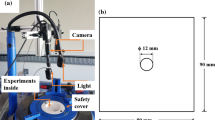Abstract
Hole expandability is a vital formability parameter for automobile body parts that are subjected to deep drawing conditions. In this paper, the influence of mechanical and fractographic properties on hole expansion ratio has been studied and reported. The hole expansion test has been carried out for seven different automotive steel sheets of varying thicknesses. Hole expansion ratio expressed in terms of hole expansion percentage is strongly influenced by the microstructure of the sheet metal. Hole expansion test experiments were performed on flat circular plates with a hole in the center to investigate the fracture behaviors of various automobile steels such as microalloyed, C–Mn, high-strength I.F. (SPRC-35) of three grades, extra galvannealed I.F., and HSLA (E-36) steel sheets. In the hole expansion test, deformation by lip is caused when the punch expands the hole. Fracture by petalling occurs when the holes in the sheets are completely pierced by the punch. Large circumferential strains are accommodated in the deforming sheet material. The mechanical properties, namely, strain hardening exponent (n), normal anisotropy (\( \overline{r} \)), formability parameter (n \( \overline{r} \)), and other properties, namely, Mohr's circle shear strains (γ 31 and γ 12), strain triaxiality factor (T), and stress triaxiality factor (T o), affected the hole expansion ratio of different steels tested. Similarly, the fractographic factors, such as void size in micrometers, void area fraction, and d-factor, affect the hole expansion ratio. Among the steel sheets tested, extra galvannealed I.F. steel possesses the highest hole expansion ratio.
Similar content being viewed by others
References
Narayanasamy R, Parthasarathi NL, Ravindran R, Sathiya Narayanan C (2008) Analysis of fracture limit curves and void coalescence in high strength interstitial free steel sheets formed under different stress conditions. J Mater Sci 43:3351–3363
Narayanasamy R, Parthasarathi NL, Sathiya Narayanan C (2009) Effect of microstructure on void nucleation and coalescence during forming of three different HSLA steel sheets under different stress conditions. Mater Des 30:1310–1324
Schey JA (1992) Formability determination for production control. J Mater Process Technol 32:207–221
Schey JA (1996) Speed effects in drawbead simulation. J Mater Process Technol 57:146–154
Leu D-K (1996) Finite-element simulation of hole-flanging process of circular sheets of anisotropic materials. Int J Mech Sci 38:917–933
Huang Y-M, Chien K-H (2001) The formability limitation of the hole-flanging process. J Mater Process Technol 117:43–51
Huang Y-M, Chien K-H (2001) Influence of the punch profile on the limitation of formability in hole-flanging process. J Mater Process Technol 113:720–724
Hyun DI, Oak SM, Kang SS, Moon YH (2002) Estimation of hole flangeability for high strength steel plates. J Mater Process Technol 130–131:9–13
Ravi Kumar D (2002) Formability analysis of extra deep drawing steel. J Mater Process Technol 130–131:31–41
Fang X, Fan Z, Ralph B, Evans P, Underhill R (2003) Effects of tempering temperature on tensile and hole expansion properties of a C–Mn steel. J Mater Process Technol 132:215–218
Lin H-S, Lee Chien-Yu, Chia-Hung Wu (2007) Hole flanging with cold extrusion on sheet metals by FE simulation. Int J Machine Tools Manufac 47:168–174
Thipprakmas S, Jin M, Murakawa M (2007) Study on flanged shapes in fineblanked-hole flanging process (FB-hole flanging process) using finite element method (FEM). J Mater Process Technol 192–193:128–133
Yuung-ming H (2007) Hole flanging with ironing process of two-ply thick sheet metal. Trans Nonferrous Met Soc China 17:221–227
Chen T-C (2007) An analysis of forming limit in the elliptic hole-flanging process of sheet metal. J Mater Process Technol 192–193:373–380
Li C-L, Huang Y-M, Tsai Yi-Wei (2008) The analysis of forming limit in re-penetration process of the hole-flanging of sheet metal. J Mater Process Technol J Mater Process Technol 201:256–260
Huang Y-M, Tsai Y-W, Li C-L (2008) Analysis of forming limits in metal forming processes. J Mater Process Technol 201:385–389
Mahendra Babu NC, Jagadish T, Ramachandra K, Sridhara SN (2008) A simplified 3-D finite element simulation of cold expansion of a circular hole to capture through thickness variation of residual stresses. Eng Failure Anal 15:339–348
Uthaisangsuk V, Prahl U, Bleck W (2008) Stretch-flangeability characterisation of multiphase steel using a microstructure based failure modelling. Comput Mater Sci 45:617–623
Narayanasamy R, Ponalagusamy R, Raghuraman S (2008) The effect of strain rate sensitivity on theoretical prediction of limiting draw ratio for cylindrical cup drawing process. Mater Des 29:884–890
Author information
Authors and Affiliations
Corresponding author
Rights and permissions
About this article
Cite this article
Narayanasamy, R., Narayanan, C.S., Padmanabhan, P. et al. Effect of mechanical and fractographic properties on hole expandability of various automobile steels during hole expansion test. Int J Adv Manuf Technol 47, 365–380 (2010). https://doi.org/10.1007/s00170-009-2201-x
Received:
Accepted:
Published:
Issue Date:
DOI: https://doi.org/10.1007/s00170-009-2201-x




